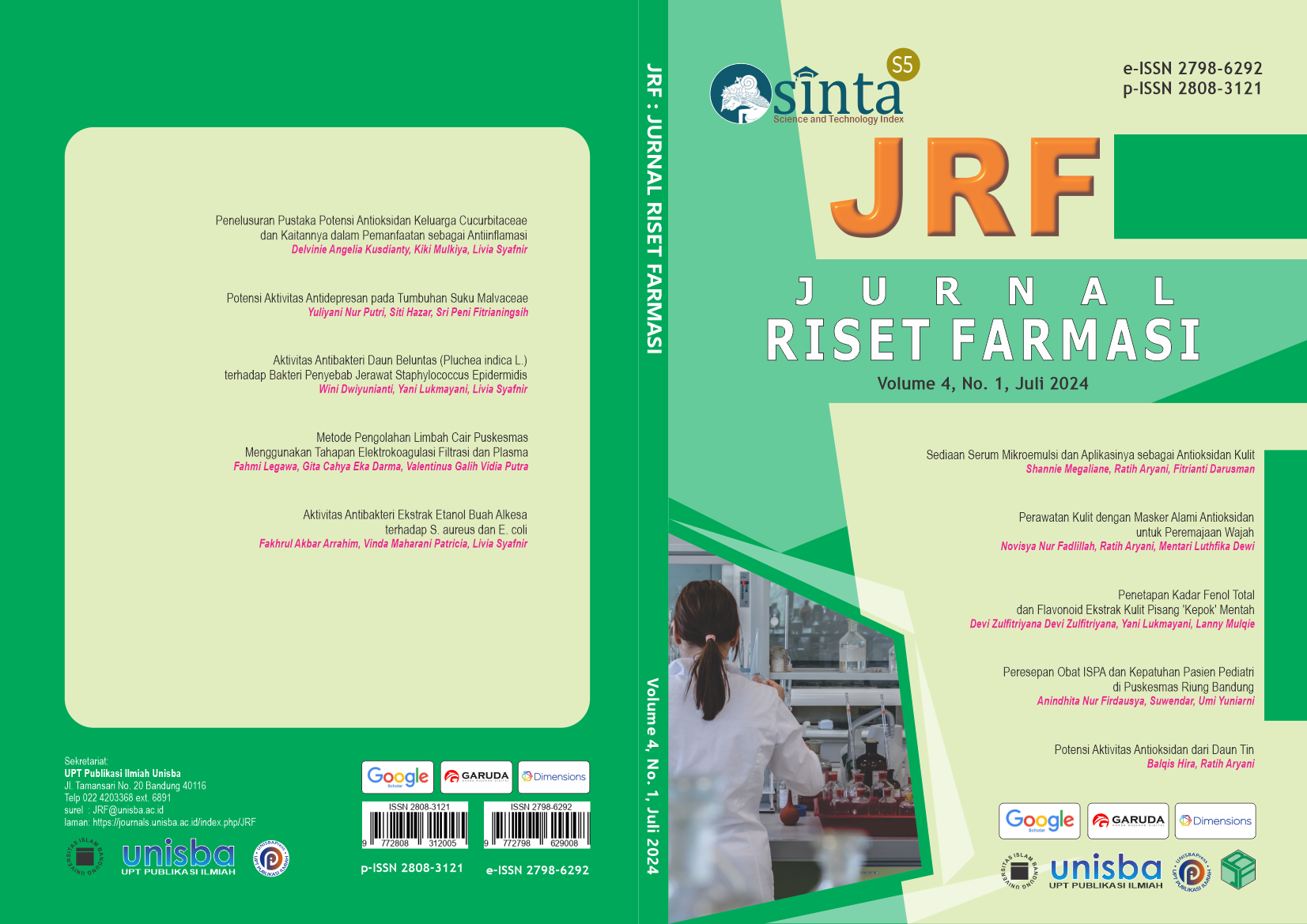Potensi Aktivitas Antidepresan pada Tumbuhan Suku Malvaceae
DOI:
https://doi.org/10.29313/jrf.v4i1.3888Keywords:
Antidepresan, Malvaceae, Study Literature ReviewAbstract
Abstrak. Depresi merupakan salah satu masalah kejiwaan yang banyak terjadi saat ini. Penggunaan antidepresan untuk mengatasi gangguan depresi memiliki efek samping yang serius bagi penggunanya. Alternatif pengobatan gangguan depresi dapat dilakukan dengan pemanfaatan bahan alam. Beberapa tanaman dari suku Malvaceae diketahui berpotensi sebagai antidepresan. Tujuan dari penelitian ini adalah untuk mengetahui potensi, golongan senyawa aktif serta mekanisme kerjanya sebagai antidepresan. Metode yang digunakan pada penelitian ini adalah Study Literature Review. Penelusuran pustaka dilakukan dengan menggunakan kata kunci “antidepresan”, “antidepressant”, “famili Malvaeae” dan “in vivo”. Berdasarkan hasil penelusuran pustaka yang diperoleh, didapatkan sebanyak 6 tanaman dari suku Malvaceae yang telah terbukti memiliki aktivitas antidepresan. Tanaman-tanaman tersebut adalah Abelmoschus manihot (L.) Medik, Adansonia digitata L., Ceiba aesculifolia (Kunth) Britten & Baker fill, Hibiscus rosa-sinensis L., Hibiscus sabdariffa Linn. dan Hibiscus syriacus L. Golongan senyawa yang berperan sebagai antidepresan adalah golongan flavonoid dengan mekanisme kerja penghambatan monoamina oksidase (MAO) dan reuptake neurotransmiter serotonin, penurunan kadar kortikosteron dan peningkatan kadar brain-derived neurothrophic factor (BDNF).
References
B. T. Baune and P. J. Tully, “Cardiovascular Disease and Depression: Treatment and Prevention in Psychocardiology,” Zhurnal Neuropatolgi Psikhiatri, vol. 97, no. 3, 2016.
T. V. Shanbhag and S. Shenoy, Pharmacology for Medical Graduates. 2015.
P. Bongiorno, “IN THERAPY Combining Natural Remedies with Conventional Care,” Ment. Heal., vol. 1, p. 290, 2015.
A. Shehu, M. G. Magaji, J. Yau, B. Mahmud, and A. Ahmed, “Antidepressant effect of methanol stem bark extract of adansonia digitata l. (malvaceae) in mice,” Trop. J. Nat. Prod. Res., vol. 2, no. 2, pp. 87–91, 2018, doi: 10.26538/tjnpr/v2i2.6.
Tika Siti Fatimah and Lanny Mulqie, “Studi Literatur Aktivitas Antibakteri dari Tanaman Famili Malvaceae,” J. Ris. Farm., vol. 1, no. 2, pp. 106–113, Dec. 2021, doi: 10.29313/jrf.v1i2.454.
N. A. Melanti, Sri Peni Fitrianingsih, and Ratu Choesrnia, “Potensi Antidepresan Beberapa Tumbuhan Suku Fabaceae,” J. Ris. Farm., vol. 1, no. 1, pp. 73–80, Oct. 2021, doi: 10.29313/jrf.v1i1.195.
R. Novelni, M. Aria, P. Minerva, and A. U. Putri, “Uji Aktivitas Antidepresan Ekstrak Etanol Daun Gedi Hijau (Abelmoschus manihot (L.) Medik) Pada Mencit Putih Jantan (Mus mussculus).,” J. Katalisator, vol. 7, no. 2, pp. 82–89, 2022.
C. I. Bustos-Gómez et al., “Neuropharmacological Activities of Ceiba aesculifolia (Kunth) Britten & Baker f (Malvaceae),” Pharmaceuticals, vol. 15, no. 12, 2022, doi: 10.3390/ph15121580.
L. Khalid, G. H. Rizwani, V. Sultana, H. Zahid, R. Khursheed, and H. Shareef, “Antidepressant activity of ethanolic extract of Hibiscus rosa sinenesis Linn.,” Pak. J. Pharm. Sci., vol. 27, no. 5, pp. 1327–1331, 2014.
Gulsheen, A. Kumar, and A. Sharma, “Antianxiety and Antidepressant Activity Guided Isolation and Characterization of Gossypetin from Hibiscus sabdariffa Linn. Calyces,” vol. 9, no. 3, pp. 205–214, 2019.
Y. H. Kim et al., “Antidepressant-Like and Neuroprotective Effects of Ethanol Extract from the Root Bark of Hibiscus syriacus L.,” Biomed Res. Int., vol. 2018, 2018, doi: 10.1155/2018/7383869.
L. Hritcu et al., “Antidepressant flavonoids and their relationship with oxidative stress,” Oxid. Med. Cell. Longev., vol. 2017, 2017, doi: 10.1155/2017/5762172.
P. B. Shewale, R. A. Patil, and Y. A. Hiray, “Antidepressant-like activity of anthocyanidins from Hibiscus rosa-sinensis flowers in tail suspension test and forced swim test,” Indian J. Pharmacol., vol. 44, no. 4, pp. 454–457, 2012.
N. P. Samant and G. L. Gupta, “Gossypetin- based therapeutics for cognitive dysfunction in chronic unpredictable stress- exposed mice,” Metab. Brain Dis., vol. 37, pp. 1527–1539, 2022.












